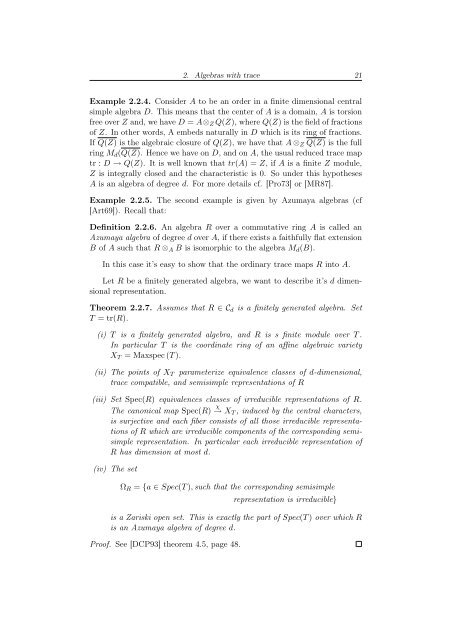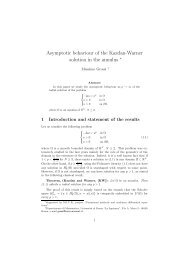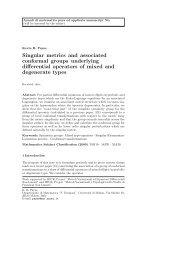Degree of Parabolic Quantum Groups - Dipartimento di Matematica ...
Degree of Parabolic Quantum Groups - Dipartimento di Matematica ...
Degree of Parabolic Quantum Groups - Dipartimento di Matematica ...
You also want an ePaper? Increase the reach of your titles
YUMPU automatically turns print PDFs into web optimized ePapers that Google loves.
2. Algebras with trace 21<br />
Example 2.2.4. Consider A to be an order in a finite <strong>di</strong>mensional central<br />
simple algebra D. This means that the center <strong>of</strong> A is a domain, A is torsion<br />
free over Z and, we have D = A⊗Z Q(Z), where Q(Z) is the field <strong>of</strong> fractions<br />
<strong>of</strong> Z. In other words, A embeds naturally in D which is its ring <strong>of</strong> fractions.<br />
If Q(Z) is the algebraic closure <strong>of</strong> Q(Z), we have that A ⊗Z Q(Z) is the full<br />
ring Md(Q(Z). Hence we have on D, and on A, the usual reduced trace map<br />
tr : D → Q(Z). It is well known that tr(A) = Z, if A is a finite Z module,<br />
Z is integrally closed and the characteristic is 0. So under this hypotheses<br />
A is an algebra <strong>of</strong> degree d. For more details cf. [Pro73] or [MR87].<br />
Example 2.2.5. The second example is given by Azumaya algebras (cf<br />
[Art69]). Recall that:<br />
Definition 2.2.6. An algebra R over a commutative ring A is called an<br />
Azumaya algebra <strong>of</strong> degree d over A, if there exists a faithfully flat extension<br />
B <strong>of</strong> A such that R ⊗A B is isomorphic to the algebra Md(B).<br />
In this case it’s easy to show that the or<strong>di</strong>nary trace maps R into A.<br />
Let R be a finitely generated algebra, we want to describe it’s d <strong>di</strong>mensional<br />
representation.<br />
Theorem 2.2.7. Assumes that R ∈ Cd is a finitely generated algebra. Set<br />
T = tr(R).<br />
(i) T is a finitely generated algebra, and R is s finite module over T.<br />
In particular T is the coor<strong>di</strong>nate ring <strong>of</strong> an affine algebraic variety<br />
XT = Maxspec(T).<br />
(ii) The points <strong>of</strong> XT parameterize equivalence classes <strong>of</strong> d-<strong>di</strong>mensional,<br />
trace compatible, and semisimple representations <strong>of</strong> R<br />
(iii) Set Spec(R) equivalences classes <strong>of</strong> irreducible representations <strong>of</strong> R.<br />
The canonical map Spec(R) χ → XT, induced by the central characters,<br />
is surjective and each fiber consists <strong>of</strong> all those irreducible representations<br />
<strong>of</strong> R which are irreducible components <strong>of</strong> the correspon<strong>di</strong>ng semisimple<br />
representation. In particular each irreducible representation <strong>of</strong><br />
R has <strong>di</strong>mension at most d.<br />
(iv) The set<br />
ΩR = {a ∈ Spec(T),such that the correspon<strong>di</strong>ng semisimple<br />
representation is irreducible}<br />
is a Zariski open set. This is exactly the part <strong>of</strong> Spec(T) over which R<br />
is an Azumaya algebra <strong>of</strong> degree d.<br />
Pro<strong>of</strong>. See [DCP93] theorem 4.5, page 48.








